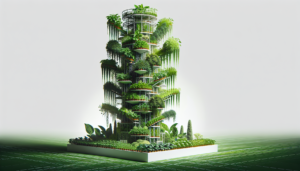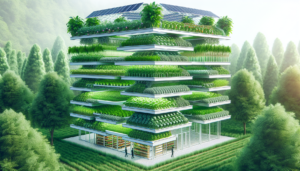
Imagine a future where Kuwait, with its limited agricultural land and water resources, can become self-sufficient in terms of food production. That future may not be too far off thanks to the potential of vertical farming. Vertical farming is an innovative method of growing crops in vertically stacked layers, using artificial lighting and controlled environments. This article explores the possibilities and advantages of vertical farming in Kuwait, and how it could revolutionize the food industry in this desert nation. Get ready to be amazed at the extraordinary potential of vertical farming and its ability to transform the way we grow our food.
Overview of Vertical Farming
Vertical farming is a innovative agricultural practice that involves growing plants in vertically stacked layers, using techniques such as hydroponics or aeroponics. This method allows for the efficient use of limited space and resources, and is gaining popularity as a solution to various challenges faced in traditional farming methods. In this article, we will explore the definition of vertical farming, its benefits, current trends, and its potential application in Kuwait.
Definition of vertical farming
Vertical farming is a type of indoor farming that utilizes vertical space to grow crops, rather than traditional horizontal methods. It typically involves the use of artificial lighting, controlled climate conditions, and innovative systems such as hydroponics or aeroponics. The crops are grown in vertically stacked layers, maximizing the use of limited space and resources.
Benefits of vertical farming
Vertical farming offers several advantages over traditional farming methods. Firstly, it allows for optimal land utilization, as crops can be grown in vertical layers, maximizing the use of limited space. This is especially beneficial in Kuwait, where arable land is limited. Secondly, vertical farming conserves water resources by using techniques such as hydroponics, which require significantly less water compared to traditional soil-based farming. Additionally, vertical farming enables controlled climate conditions, providing a stable environment for crops to thrive regardless of the extreme weather conditions that Kuwait often experiences. Lastly, vertical farming allows for year-round crop production, ensuring a consistent and reliable food supply.
Current trends in vertical farming
Vertical farming is a rapidly growing industry worldwide, with new technologies and practices constantly emerging. Some current trends in vertical farming include the use of advanced LED lighting technologies that mimic natural sunlight, the development of vertical farming systems that can be integrated into urban spaces, and the adoption of automation and artificial intelligence to optimize crop production. These trends indicate the growing potential of vertical farming as a sustainable and efficient method of food production.
Agricultural Challenges in Kuwait
Kuwait faces several challenges in traditional agriculture due to its unique geographical and climatic conditions.
Limited arable land
One of the major challenges in Kuwait is the limited availability of arable land. With a small land area and a growing population, the demand for food production is continuously increasing. However, the scarcity of fertile land poses a significant constraint on traditional farming methods.
Water scarcity
Kuwait suffers from a severe shortage of water resources, making it difficult to sustain conventional agricultural practices. The arid climate and limited freshwater sources further exacerbate this issue, requiring innovative solutions to conserve water and achieve sustainable agriculture.
Extreme weather conditions
Kuwait experiences extreme weather conditions, including high temperatures, sandstorms, and low humidity. These conditions can have a detrimental impact on crop yields, making it challenging for traditional farming to thrive. Adaptation to these conditions is crucial for successful agricultural practices in Kuwait.
Advantages of Vertical Farming in Kuwait
Vertical farming presents several advantages that make it particularly suitable for overcoming the agricultural challenges faced in Kuwait.
Optimal land utilization
Vertical farming allows for optimal land utilization by utilizing vertical space instead of traditional horizontal methods. By growing crops in vertically stacked layers, farmers can maximize the use of limited available land. This is especially beneficial in Kuwait, where arable land is scarce.
Conservation of water resources
One of the key advantages of vertical farming is its ability to conserve water resources. Techniques such as hydroponics, which involve growing plants without soil and using nutrient-rich water solutions, significantly reduce water consumption compared to traditional soil-based farming. Vertical farming also enables the recycling and reuse of water, further minimizing water waste.
Controlled climate conditions
Vertical farming provides the ability to control climate conditions, ensuring optimal growth for crops regardless of the extreme weather conditions in Kuwait. By maintaining stable temperature, humidity, and lighting levels, farmers can create an ideal environment for plant growth. This allows for year-round production and minimizes the negative impact of extreme weather on crop yields.
Year-round crop production
Vertical farming enables year-round crop production, ensuring a consistent and reliable food supply in Kuwait. By utilizing artificial lighting and climate control systems, farmers can create an environment that mimics ideal growing conditions, allowing for continuous cultivation. This reduces dependence on seasonal fluctuations and external factors that can affect traditional agriculture.
Suitable Crops for Vertical Farming in Kuwait
Vertical farming is well-suited for the cultivation of certain crops that thrive in controlled environments and require minimal space. Some suitable crops for vertical farming in Kuwait include:
Leafy greens
Leafy greens such as lettuce, spinach, and kale are ideal crops for vertical farming. They have a short growth cycle, can tolerate high-density planting, and are rich in nutrients. Additionally, leafy greens have a high demand and are staple ingredients in many cuisines, making them a lucrative option for vertical farmers in Kuwait.
Herbs
Herbs such as basil, mint, and parsley are well-suited for vertical farming. They require relatively less space compared to other crops and have a high market value. The controlled climate conditions in vertical farms allow for optimum growth, resulting in high-quality herbs with intense flavors and aromas.
Microgreens
Microgreens are young vegetable greens harvested at an early stage of growth. They are packed with nutrients and are increasingly popular in the culinary world. Their small size and quick growth cycle make them ideal for vertical farming, where they can be grown in high-density arrays.
Strawberries
Strawberries can be successfully grown in vertical farming systems, as they prefer well-controlled environments and can be grown hydroponically. By utilizing vertical stacking systems, farmers can maximize strawberry production in limited space. The controlled climate conditions also help in achieving consistent fruit quality and yield.
Techniques and Tools Used in Vertical Farming
Vertical farming incorporates various techniques and tools to create optimal growing conditions for crops. Here are some commonly used techniques and tools in vertical farming:
Hydroponics
Hydroponics is a technique that involves growing plants without soil, using nutrient-rich water solutions. It conserves water resources, allows for precise control of nutrient levels, and promotes fast, healthy growth. Hydroponics is widely used in vertical farming due to its high efficiency and versatility.
Aeroponics
Aeroponics is a method where plants are cultivated in an air or mist environment, without soil or hydroponic medium. The roots are suspended in a nutrient-rich mist, allowing for maximum oxygen exposure. Aeroponics promotes rapid growth, conserves water, and reduces the risk of diseases and pests. This technique is ideal for vertical farming where space and resource optimization are essential.
Stacking systems
Vertical farms utilize stacking systems to maximize the use of vertical space. These systems typically consist of vertical shelves or racks with multiple layers for crop cultivation. Stacking systems allow for high-density planting and efficient space utilization, enabling farmers to grow more crops in a limited area.
Artificial lighting
Vertical farms rely on artificial lighting to provide the necessary light spectrum for plant growth. LED lights are commonly used due to their energy efficiency and the ability to provide specific wavelengths required for photosynthesis. Artificial lighting allows for year-round production and can be customized to the specific needs of different crops.
Success Stories of Vertical Farming in Kuwait
Several successful vertical farming initiatives have emerged in Kuwait, showcasing the potential of this farming method in the country. Here are some notable success stories:
3ra Sustainable Living
3ra Sustainable Living is a vertical farming company based in Kuwait that specializes in rooftop farming. They have transformed unused rooftops into productive agricultural spaces, growing a variety of crops including leafy greens and herbs. Their sustainable farming practices and commitment to environmental stewardship have earned them recognition in the region.
Inagro
Inagro is an indoor vertical farming company that utilizes advanced technologies to grow high-quality crops. They focus on the cultivation of leafy greens and herbs, utilizing hydroponics to maximize resource efficiency. Inagro’s vertical farming models have demonstrated high productivity and exceptional crop quality.
Naqsa Kuwait
Naqsa Kuwait is a hydroponic greenhouse located in Kuwait that specializes in vertical farming. They produce a wide range of fruits and vegetables, including strawberries, tomatoes, and cucumbers. Naqsa Kuwait has successfully implemented vertical farming techniques to overcome the challenges of limited space and extreme weather conditions.
Government Support and Initiatives
The Kuwaiti government recognizes the importance of vertical farming in addressing the agricultural challenges faced in the country. Several support initiatives have been implemented to promote and encourage vertical farming practices. Some prominent government support and initiatives include:
Kuwait National Development Plan
The Kuwait National Development Plan emphasizes sustainable development and includes provisions for promoting innovative agricultural practices. It encourages investment in vertical farming and supports research and development in this field. The plan aims to enhance food security, reduce dependence on imports, and promote sustainable resource management.
Kuwait Institute for Scientific Research
The Kuwait Institute for Scientific Research (KISR) plays a crucial role in promoting scientific research and development in Kuwait. KISR conducts research in various fields, including agriculture, and offers expertise and resources to support the implementation of vertical farming projects. Their research findings and recommendations contribute to the growth and development of vertical farming in Kuwait.
Kuwait Foundation for the Advancement of Sciences
The Kuwait Foundation for the Advancement of Sciences (KFAS) actively supports research and innovation in various sectors, including agriculture. Through funding and grants, KFAS encourages the development of sustainable farming practices, including vertical farming. Their support enables entrepreneurs, researchers, and farmers to explore and implement innovative solutions in agricultural production.
Challenges and Limitations
While vertical farming presents numerous advantages, there are also challenges and limitations that need to be addressed:
High initial investment
Vertical farming requires a significant upfront investment to set up the necessary infrastructure and technology. The cost of equipment, lighting systems, and climate control measures can be substantial. This initial investment may deter some farmers from adopting vertical farming practices.
Energy consumption
Vertical farms rely heavily on artificial lighting and climate control systems, resulting in increased energy consumption. This can lead to higher operational costs and dependence on non-renewable energy sources. Finding sustainable and energy-efficient solutions is crucial to mitigate the impact of energy consumption in vertical farming.
Limited crop variety
Vertical farming is best suited for certain crops that can thrive in controlled environments. This limits the variety of crops that can be grown and may not cater to the full range of food demands. However, advancements in vertical farming techniques and breeding programs can help expand the range of crops suitable for vertical farming.
Future Potential of Vertical Farming in Kuwait
Vertical farming has immense future potential in Kuwait. With the ongoing advancement in technology, the expansion of vertical farming is highly likely. Some potential areas of growth include:
Expansion of vertical farming
As awareness and knowledge of vertical farming practices increase, more farmers and entrepreneurs are likely to adopt this method. The expansion of vertical farming in Kuwait can lead to increased food production, enhanced food security, and reduced dependence on imports. It can also create employment opportunities and contribute to the country’s economic growth.
Integration with smart city initiatives
Kuwait has embarked on various smart city initiatives that aim to utilize advanced technologies for sustainable urban development. Vertical farming can be integrated into these initiatives, enabling food production within urban areas. This integration can promote resource optimization, reduce food miles, and enhance the overall sustainability of the city.
Export opportunities
Vertical farming has the potential to transform Kuwait into an exporter of high-quality, locally grown produce. By capitalizing on the controlled environment and consistently high-quality crops, Kuwait can expand its agricultural exports and contribute to food security in neighboring countries.
Conclusion
Vertical farming offers a promising solution to the agricultural challenges faced in Kuwait. With limited arable land, water scarcity, and extreme weather conditions, traditional farming practices struggle to meet the country’s food demands. Vertical farming provides opportunities for optimal land utilization, conservation of water resources, controlled climate conditions, and year-round crop production. Advancements in technology, government support, and successful case studies further highlight the potential of vertical farming in Kuwait. By embracing this innovative agricultural practice, Kuwait can enhance food security, promote sustainability, and drive economic growth in the future.







